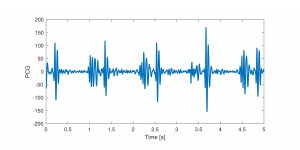Separation of biomedical signals
Description of the challenge:
Phonocardiography (PCG) is the recording of the sounds generated by the heart. It allows to evaluate some vital functions of the heart.However, the raw recordings of the PCG are not always directly exploitable because of ambiant interferences (e.g., speech, cough, gastric noise, etc). Consequently, it is necessary to denoise the raw PCG before their interpretation. An exemple of clean PCG is plotted below:
The aim of this challenge is to extract the heart activity from raw PCG recordings with a single microphone maintained on the skin, in front of the hear, by a belt. 16 sessions have been recorded from healthy participants in different conditions.
Description of the data
The provided noisy recordings have been artificially created from a clean PCG and different interferences signals: each actual signal has been recorded separately.
The recordings have been bandpass filtered between 15Hz and 300Hz and the sampling frequency is 1kHz.
The testing files are Matlab “.mat” files containing
- the single mixture denotes “x” of dimension 1-by-“number of time samples”
- the sampling frequency “fs” in Hz
Evaluation
The quality of the separation process will be evaluated by the BSS-eval toolbox [1].
The SDR, SIR and SAR indexes will be computed on sliding windows of 1 second with an overlap of 0.5 second.
The performance will then only retain the indexes related to the heart sounds.
The data may be downloaded here
Submission of results
The participants are asked to submit their results as a Matlab “.mat” file containing the estimation of the PCG signal only.
For each original file, the results will be stored into a file denoted [‘S’ numberOfFile ‘_Result’]: for example, the results corresponding of file “S4.mat” will be named “S4_Result.mat”.
This file will contain a unique row vector denoted “sEst” of dimension 1-by-“number of time samples”, where “number of time samples” must be equal to the original number of samples (i.e. no cropping).
This vector is the estimation of the PCG signal.
Each participant should then send an email to Bertrand Rivet at: bertrand(dot)rivet(at)gipsa-lab(dot)grenoble-inp(dot)fr providing:
- contact information (name, affiliation)
- basic information about the used algorithm and a bibliographical reference if possible
- the URL of the tarball or zip file
In case of any question, please ask Bertrand Rivet
[1] Emmanuel Vincent, Rémi Gribonval, and Cédric Févotte, “Performance measurement in blind audio source separation,” IEEE Trans. on Audio, Speech and Language Processing, 14(4):1462-1469, 2006.

